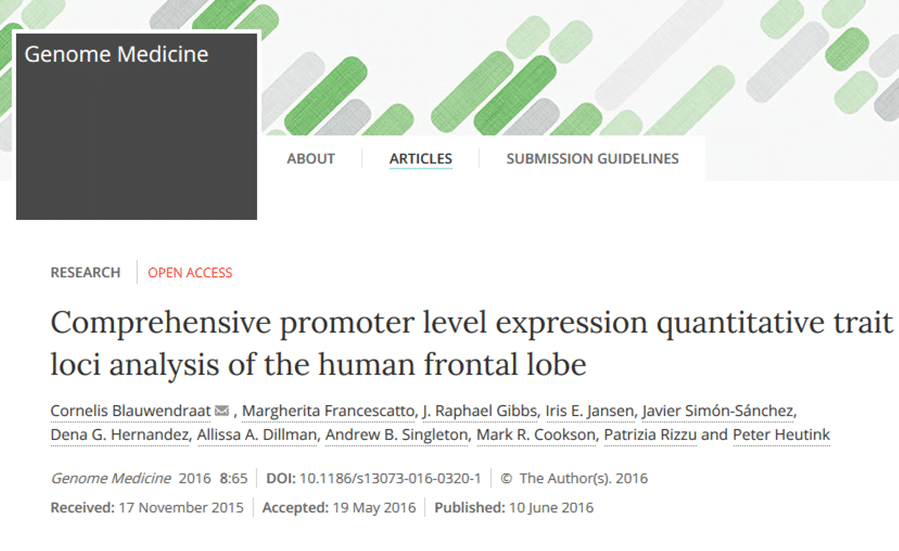 “Low Cerebrospinal Fluid Amyloid-Beta Concentration Is Associated with Poorer Delayed Memory Recall in Women” has been published in Dementia and Geriatric Cognitive Disorders Extra. This research was supported in part through the BIOMARKAPD project, selected in the 2011 biomarkers call.
“Low Cerebrospinal Fluid Amyloid-Beta Concentration Is Associated with Poorer Delayed Memory Recall in Women” has been published in Dementia and Geriatric Cognitive Disorders Extra. This research was supported in part through the BIOMARKAPD project, selected in the 2011 biomarkers call.
Tag Archives: JPND
 “Fibroblasts of Machado Joseph Disease patients reveal autophagy impairment” has been published in Scientific Reports. This research was supported in part by JPND through the ModelPolyQ project, selected for support under the 2015 JPco-fuND call, and the SynSpread project, selected for support under the 2013 cross-disease call.
“Fibroblasts of Machado Joseph Disease patients reveal autophagy impairment” has been published in Scientific Reports. This research was supported in part by JPND through the ModelPolyQ project, selected for support under the 2015 JPco-fuND call, and the SynSpread project, selected for support under the 2013 cross-disease call.
 “Laser capture microscopy coupled with Smart-seq2 for precise spatial transcriptomic profiling” has been published in Nature Communications. This research was supported in part by JPND through the DAMNDPATHS project, selected under the 2013 cross-disease analysis call.
“Laser capture microscopy coupled with Smart-seq2 for precise spatial transcriptomic profiling” has been published in Nature Communications. This research was supported in part by JPND through the DAMNDPATHS project, selected under the 2013 cross-disease analysis call.
 “Pittsburgh compound B imaging and cerebrospinal fluid amyloid-β in a multicentre European memory clinic study” has been published in Brain. This research was supported in part by JPND through the BiomarkAPD project, selected under the 2011 biomarkers call.
“Pittsburgh compound B imaging and cerebrospinal fluid amyloid-β in a multicentre European memory clinic study” has been published in Brain. This research was supported in part by JPND through the BiomarkAPD project, selected under the 2011 biomarkers call.
 “Application of an in vitro-amplification assay as a novel pre-screening test for compounds inhibiting the aggregation of prion protein scrapie” has been published in Scientific Reports. This research was supported in part by JPND through the DEMTEST project, selected under the 2011 biomarkers call.
“Application of an in vitro-amplification assay as a novel pre-screening test for compounds inhibiting the aggregation of prion protein scrapie” has been published in Scientific Reports. This research was supported in part by JPND through the DEMTEST project, selected under the 2011 biomarkers call.
 “Comprehensive promoter level expression quantitative trait loci analysis of the human frontal lobe” has been published in Genome Medicine. This research was supported in part by JPND through the RiMod-FTD project, selected under the 2012 risk factors call.
“Comprehensive promoter level expression quantitative trait loci analysis of the human frontal lobe” has been published in Genome Medicine. This research was supported in part by JPND through the RiMod-FTD project, selected under the 2012 risk factors call.
Ten international JPND working groups recommended for funding
The EU Joint Programme – Neurodegenerative Disease Research (JPND) has released the results of a “rapid-action” call to support working groups of leading scientists to bring forward novel approaches that will enhance the use of brain imaging for neurodegenerative disease research.
Ten working groups have been recommended for funding to address the methodological challenges facing different imaging modalities, among them MRI, PET, ultrasound, MEG and EEG, as well as multimodal approaches. The working groups cover a range of neurodegenerative diseases, including Alzheimer’s disease, Parkinson’s disease, Frontotemporal dementia and Huntington’s disease.
“Brain imaging has made enormous progress in recent years and is currently one of the most promising avenues in neurodegenerative disease research,” said Professor Thomas Gasser, Chair of the JPND Scientific Advisory Board. “If we can solve the challenges in the field, brain imaging could rapidly lead to faster and better diagnoses as well as a deeper understanding of the fundamental aspects and mechanisms of neurodegeneration.”
Although imaging techniques have brought about a dramatic improvement in the understanding of neurodegenerative diseases, there remain a number of significant challenges in the field. These include the execution of multi-centre clinical trials of an unprecedented scale, data transfer across imaging centres and the use of imaging for diagnostics and for measuring clinical outcomes.
To address these questions, on January 8, 2016, JPND launched a call for community-led working groups on harmonisation and alignment in brain imaging methods. The proposals recommended for funding are for top scientists to come together and propose, through ‘best practice’ guidelines and/or methodological frameworks, how to overcome key barriers to the use of imaging in neurodegenerative disease research.
The call attracted proposals with partners from across Europe and beyond, including Asia, Australia, North America and South America. A notable number of groups based in the United States were involved in responses to the call. Funding decisions were based upon scientific evaluation and recommendations to sponsor countries by a JPND peer review panel.
“This call perfectly embodies JPND’s mission and objectives,” said Professor Philippe Amouyel, Chair of the JPND Management Board. “The purpose of JPND is to strengthen coordination and collaboration in neurodegenerative disease research across different countries. We want to ensure that research efforts are not duplicated, to build consensus and to accelerate a path toward a cure that works. This call convenes groups of leading experts to hammer out the hard questions, including the challenges of interoperability and shared and open data, to allow researchers to more rapidly and more fully exploit imaging techniques going forward.”
Each working group is expected to run for a maximum of 9 months. The outputs of the working groups are to be produced by the end of the funding period, and will be published on the JPND website and used for further JPND actions. In addition, a common workshop will be organised to bring together and present the recommendations of each working group, encouraging the further exchange of ideas and wider dissemination to different stakeholder groups.
For more information on the working groups recommended for funding, click here.
 “Creation of a library of induced pluripotent stem cells from Parkinsonian patients” has been published in npj Parkinson’s Disease. This research was supported in part by JPND through the MADGIC project, selected under the 2015 JPco-fuND call.
“Creation of a library of induced pluripotent stem cells from Parkinsonian patients” has been published in npj Parkinson’s Disease. This research was supported in part by JPND through the MADGIC project, selected under the 2015 JPco-fuND call.
 “Aiming for Study Comparability in Parkinson’s Disease: Proposal for a Modular Set of Biomarker Assessments to be Used in Longitudinal Studies” has been published in Frontiers in Aging Neuroscience. This research was supported by JPND through the BioLoC-PD working group, selected under the 2014 call for working groups to inform cohort studies in neurodegenerative disease research.
“Aiming for Study Comparability in Parkinson’s Disease: Proposal for a Modular Set of Biomarker Assessments to be Used in Longitudinal Studies” has been published in Frontiers in Aging Neuroscience. This research was supported by JPND through the BioLoC-PD working group, selected under the 2014 call for working groups to inform cohort studies in neurodegenerative disease research.
 “Presenilin 2 Modulates Endoplasmic Reticulum-Mitochondria Coupling by Tuning the Antagonistic Effect of Mitofusin 2” has been published in Cell Reports. This research was supported in part by JPND through the CeBioND project, which was selected in the 2013 call for research projects for the cross-disease analysis of pathways related to neurodegenerative diseases.
“Presenilin 2 Modulates Endoplasmic Reticulum-Mitochondria Coupling by Tuning the Antagonistic Effect of Mitofusin 2” has been published in Cell Reports. This research was supported in part by JPND through the CeBioND project, which was selected in the 2013 call for research projects for the cross-disease analysis of pathways related to neurodegenerative diseases.
